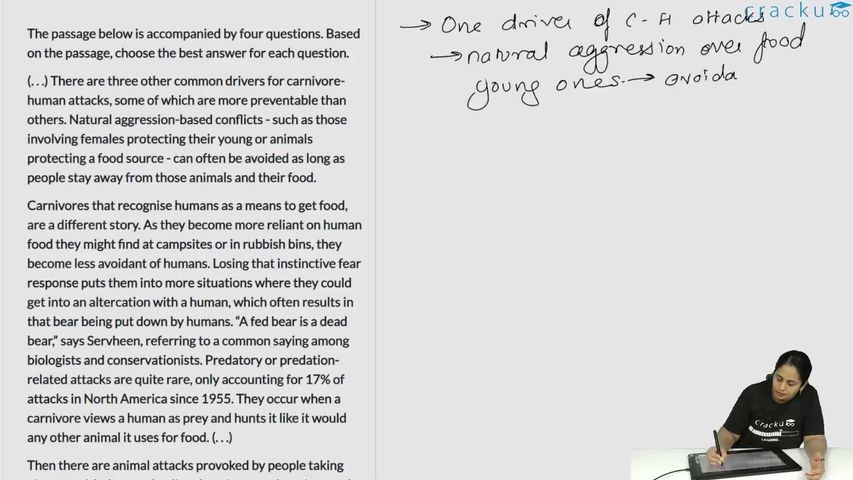Sign in
Please select an account to continue using cracku.in
↓ →
The passage below is accompanied by four questions. Based on the passage, choose the best answer for each question.
(. . .) There are three other common drivers for carnivore-human attacks, some of which are more preventable than others. Natural aggression-based conflicts - such as those involving females protecting their young or animals protecting a food source - can often be avoided as long as people stay away from those animals and their food.
Carnivores that recognise humans as a means to get food, are a different story. As they become more reliant on human food they might find at campsites or in rubbish bins, they become less avoidant of humans. Losing that instinctive fear response puts them into more situations where they could get into an altercation with a human, which often results in that bear being put down by humans. “A fed bear is a dead bear,” says Servheen, referring to a common saying among biologists and conservationists. Predatory or predation-related attacks are quite rare, only accounting for 17% of attacks in North America since 1955. They occur when a carnivore views a human as prey and hunts it like it would any other animal it uses for food. (. . .)
Then there are animal attacks provoked by people taking pictures with them or feeding them in natural settings such as national parks which often end with animals being euthanised out of precaution. “Eventually, that animal becomes habituated to people, and [then] bad things happen to the animal. And the folks who initially wanted to make that connection don’t necessarily realise that,” says Christine Wilkinson, a postdoctoral researcher at UC Berkeley, California, who’s been studying coyote-human conflicts.
After conducting countless postmortems on all types of carnivore-human attacks spanning 75 years, Penteriani’s team believes 50% could have been avoided if humans reacted differently. A 2017 study co-authored by Penteriani found that engaging in risky behaviour around large carnivores increases the likelihood of an attack.
Two of the most common risky behaviours are parents leaving their children to play outside unattended and walking an unleashed dog, according to the study. Wilkinson says 66% of coyote attacks involve a dog. “[People] end up in a situation where their dog is being chased, or their dog chases a coyote, or maybe they’re walking their dog near a den that’s marked, and the coyote wants to escort them away,” says Wilkinson.
Experts believe climate change also plays a part in the escalation of human-carnivore conflicts, but the correlation still needs to be ironed out. “As finite resources become scarcer, carnivores and people are coming into more frequent contact, which means that more conflict could occur,” says Jen Miller, international programme specialist for the US Fish & Wildlife Service. For example, she says, there was an uptick in lion attacks in western India during a drought when lions and people were relying on the same water sources.
(. . .) The likelihood of human-carnivore conflicts appears to be higher in areas of low-income countries dominated by vast rural landscapes and farmland, according to Penteriani’s research. “There are a lot of working landscapes in the Global South that are really heterogeneous, that are interspersed with carnivore habitats, forests and savannahs, which creates a lot more opportunity for these encounters, just statistically,” says Wilkinson.
Given the insights provided by Penteriani’s research and Wilkinson’s statement, which of the following conclusions can be drawn about the relationship between landscape heterogeneity and human-carnivore conflicts?
Option D is the correct answer. The passage mentions that landscape heterogeneity (a mix of farmland, forests, and carnivore habitats ) in rural areas of low-income countries creates more opportunities for human-carnivore encounters.
As Penteriani’s research shows, such landscapes increase the statistical probability of these conflicts because the areas are interspersed with human and carnivore habitats. This aligns with option D.
Option A: This is inconsistent with the passage. The passage states, "The likelihood of human-carnivore conflicts appears to be higher in areas of low-income countries dominated by vast rural landscapes and farmland". Therefore, it is not less prone, rather more prone as per the passage.
Option B: The passage does not claim that landscape heterogeneity inherently decreases the chances of human-carnivore conflict. Instead, it states that diversity increases the likelihood of encounters rather than reducing it.
Option C: The passage does not state that homogeneous landscapes cause high rates of conflict due to predictability. Instead, it suggests that landscape heterogeneity increases encounters.

Click on the Email ☝️ to Watch the Video Solution
Create a FREE account and get:
Educational materials for CAT preparation